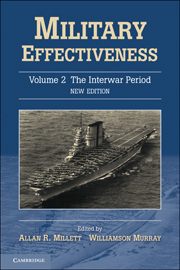Book contents
- Frontmatter
- Contents
- List of Contributors
- Introduction: Military Effectiveness Twenty Years After
- Maps
- 1 The Soviet Armed Forces in the Interwar Period
- 2 The French Armed Forces, 1918–40
- 3 The Military Effectiveness of the US Armed Forces, 1919–39
- 4 The British Armed Forces, 1918–39
- 5 Japanese Military Effectiveness: The Interwar Period
- 6 The Italian Armed Forces, 1918–40
- 7 German Military Effectiveness between 1919 and 1939
- 8 Military Effectiveness of Armed Forces in the Interwar Period, 1919–41: A Review
- Index
5 - Japanese Military Effectiveness: The Interwar Period
Published online by Cambridge University Press: 05 June 2012
- Frontmatter
- Contents
- List of Contributors
- Introduction: Military Effectiveness Twenty Years After
- Maps
- 1 The Soviet Armed Forces in the Interwar Period
- 2 The French Armed Forces, 1918–40
- 3 The Military Effectiveness of the US Armed Forces, 1919–39
- 4 The British Armed Forces, 1918–39
- 5 Japanese Military Effectiveness: The Interwar Period
- 6 The Italian Armed Forces, 1918–40
- 7 German Military Effectiveness between 1919 and 1939
- 8 Military Effectiveness of Armed Forces in the Interwar Period, 1919–41: A Review
- Index
Summary
Introduction
From the Meiji Restoration in 1868 to 1945, the Japanese armed services provided the foundation for plans to identify, protect, modernize, and expand Japan's national interests. By the end of the First World War Japan was recognized as one of the great powers. At the same time the East Asian newcomer started to face its severest test – a struggle of traditional national and cultural values against the modern challenges and opportunities as a new member of the international community of first-class powers. Political, economic, and military power rested at the heart of Japan's new-found position on the international scene, but it was also painfully evident to the Japanese that they were not recognized as an equal by the great powers, particularly by the United States.
At the Versailles Peace Conference in 1919Japan proposed the acceptance in the preamble of the Covenant of the League of Nations of a general principle recognizing racial equality: signatories were to accord to all alien nationals equal and just treatment in every respect while making no distinction on account of their race or nationality. Although eleven out of seventeen votes in the League Commission were recorded in favor of the Japanese amendment, US President Woodrow Wilson, as chairman of the commission and with the support of the British and Australians, declared it lost, under the unanimity principle. At the same time, through the insistent demand of Wilson, the Monroe Doctrine reservation was inserted in the Covenant of the League of Nations.
- Type
- Chapter
- Information
- Military Effectiveness , pp. 131 - 168Publisher: Cambridge University PressPrint publication year: 2010
- 1
- Cited by



